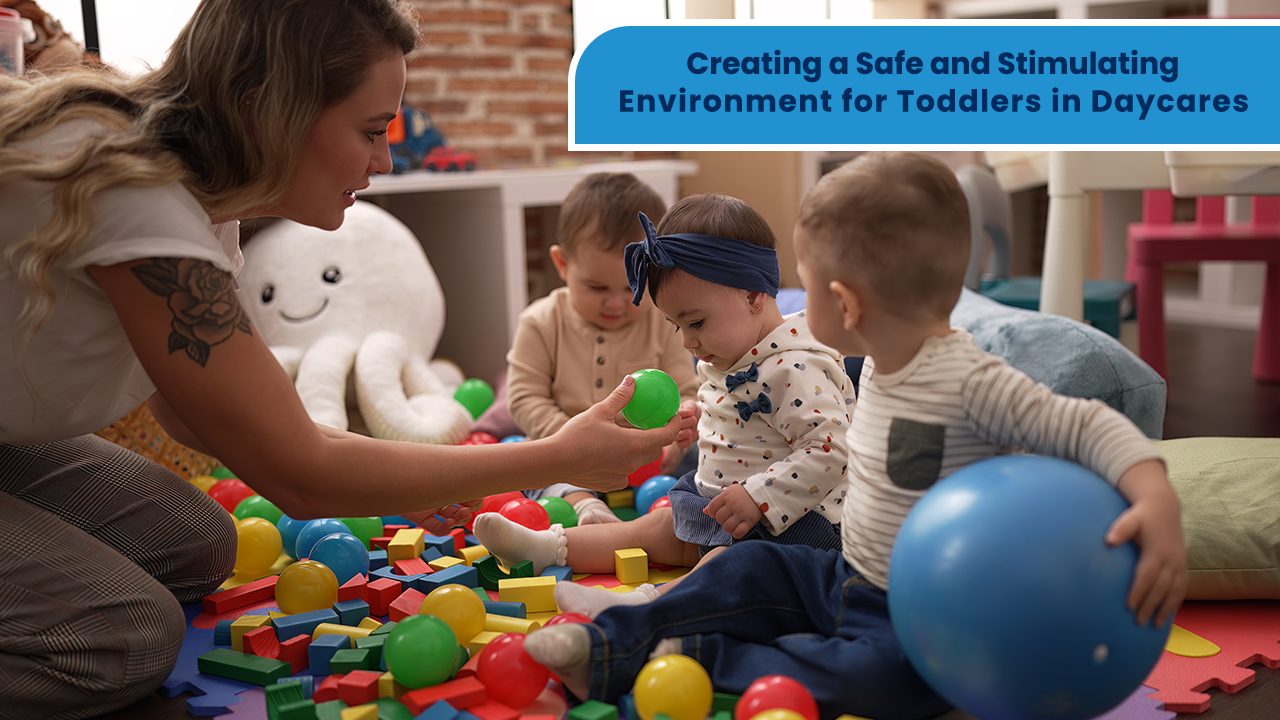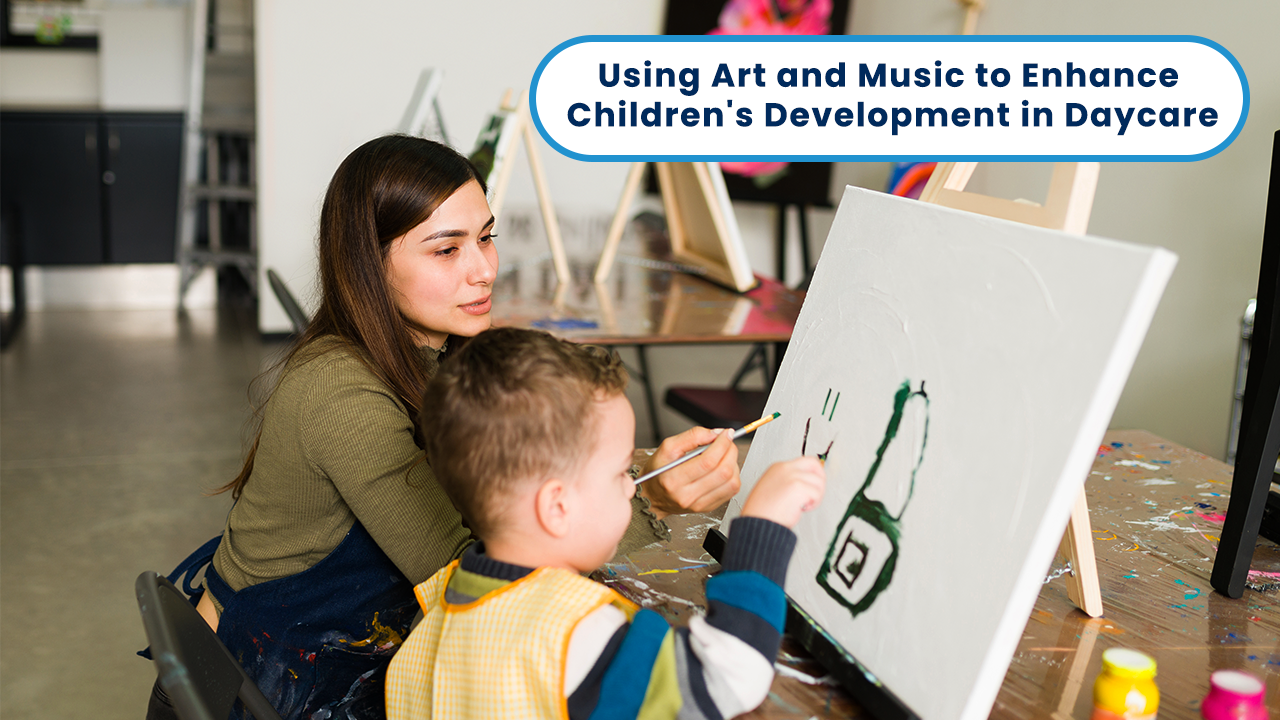
Daycares play a pivotal role in the early development of toddlers, serving as a second home where they learn, play, and grow. Creating a safe and stimulating environment for toddlers in daycare settings is crucial for both the well-being and development of these little ones. This blog will explore practical strategies and considerations for daycare providers and parents to ensure toddlers thrive in a secure and enriching environment.
Creating a Safe and Stimulating Environment for Toddlers in Daycares
1: Safety Measures in Daycare Spaces
Childproofing:
Childproofing is essential to ensuring toddlers’ safety in daycare spaces. Anchoring heavy furniture prevents the risk of tipping, while using soft corner protectors minimizes the chance of injuries from sharp edges. Installing childproof outlet covers and managing cords are critical measures to guarantee electrical safety, reducing the potential for accidents during play.
Emergency Preparedness:
Daycare providers must prioritize emergency preparedness to create a secure environment. Establishing clear exit routes and conducting regular fire drills ensures that staff and children are familiar with evacuation procedures, promoting a swift and organized emergency response. Maintaining well-equipped first aid kits and providing staff with CPR training are crucial components of emergency preparedness, enabling immediate and effective responses to unforeseen situations.
Supervision and staffing:
Adequate supervision is paramount in daycare spaces to guarantee the safety of toddlers. Adhering to recommended staff-to-child ratios ensures constant control, creating a safe and stimulating environment for toddlers where potential hazards can be identified and addressed promptly. Encouraging active monitoring by staff enhances the overall safety of the daycare, allowing for quick intervention to prevent accidents and injuries.
Health and Hygiene:
Health and hygiene protocols are vital in maintaining a safe daycare environment. Implementing a strict handwashing routine for both staff and children helps prevent the spread of germs and infections. Regular cleaning schedules for toys, play areas, and shared surfaces contribute to a sanitary atmosphere, reducing the risk of illness transmission. Conducting health screenings for staff and children ensures the early detection and containment of contagious illnesses.
Security Measures:
Security measures are integral to safeguarding toddlers in daycare. Limiting access to the daycare through secure entrances helps create a controlled environment. Strict policies regarding authorized individuals during child pickups contribute to the facility’s overall security, ensuring that children are released only to approved individuals and enhancing their safety.
2- Creating Stimulating Learning Areas
Educational Play Zones:
Establishing dedicated educational play zones is foundational to creating a safe and stimulating environment for toddlers in daycare. These areas should have age-appropriate toys that capture attention and facilitate sensory exploration. Vibrant colors, varied textures, and interactive features in toys contribute to developing essential cognitive and motor skills.
Varied Learning Centers:
Diverse learning centers within the daycare offer toddlers opportunities for comprehensive skill development. Art corners, sensory play areas, and building block stations cater to different facets of a child’s growth, encouraging creativity, fine motor skills, and problem-solving abilities. The rotation of activities within these centers ensures that toddlers encounter new challenges regularly, promoting sustained engagement and a well-rounded developmental experience.
Outdoor Spaces:
Well-designed outdoor spaces play a pivotal role in the holistic development of toddlers. These areas provide opportunities for physical activity, exploration, and a connection with the natural world. Incorporating natural elements, such as plants and rocks, enriches the sensory experience, while supervised nature exploration through activities like nature walks contributes to a toddler’s understanding and appreciation of their surroundings.
Nature Exploration:
Actively encouraging nature exploration complements the learning experience by allowing toddlers to engage with the world outside the confines of indoor spaces. Planned activities like nature walks and outdoor play sessions expose children to the diversity of the natural environment. This exposure stimulates their curiosity, enhances observational skills, and fosters a sense of wonder about the world, contributing to their overall cognitive and emotional development.
Interactive Learning Spaces:
Creating interactive learning spaces is fundamental to stimulating toddlers’ cognitive development. Hands-on activities that encourage problem-solving, critical thinking, and imaginative play form the cornerstone of early childhood education. These spaces provide an environment where toddlers can actively participate in the learning process, laying the foundation for essential skills such as communication, creativity, and logical reasoning.
How Parents Participate in Creating a Safe and Stimulating Environment for Toddlers
Parents play a crucial role in creating a safe and stimulating environment for toddlers in daycare. Collaboration with daycare providers ensures their children’s holistic and supportive experience. Here are ways in which parents can actively participate:
Open Communication:
Establishing open and regular communication with daycare providers is paramount. Parents should share relevant information about their child’s habits, preferences, and needs. This collaboration helps daycare staff tailor activities to align with the child’s development, ensuring a personalized and stimulating experience.
Understanding Daycare Policies:
Parents should take the time to understand and adhere to daycare policies thoroughly. This includes respecting drop-off and pick-up times, following health and safety guidelines, and staying informed about any specific rules related to the daycare environment. A shared commitment to these policies creates a cohesive and secure atmosphere for all children.
Participating in Parent-Teacher Meetings:
Attending parent-teacher meetings allows parents to discuss their child’s progress, share insights about their development at home, and gain a deeper understanding of the daycare’s curriculum. This collaboration ensures parents and daycare providers are on the same page regarding the child’s well-being and educational journey.
Providing comfort items:
Bringing familiar comfort items from home, such as a favorite blanket or stuffed animal, can offer toddlers a sense of security in the daycare environment. Parents can communicate with daycare providers about any special items that help ease the transition for their child, contributing to a smoother and more comforting experience.
Supporting Consistent Routines:
Consistency is vital for toddlers, and parents can support the daycare’s efforts by maintaining consistent routines at home. This includes sleep schedules, meal times, and other daily activities. When daycare and home environments align in practice, toddlers feel a sense of predictability, promoting a smoother transition between the two settings.
Providing feedback and suggestions:
Participating in feedback sessions and offering constructive suggestions can enhance the daycare experience for parents and toddlers. Sharing insights about what works well or any concerns helps daycare providers continually improve and adapt their practices to meet the unique needs of each child.
Volunteering for Events and Activities:
Parents can actively participate in daycare events and activities, contributing to a sense of community and involvement. Whether helping organize a particular day or participating in field trips. Parent engagement fosters a positive and enriching environment for toddlers, creating lasting memories and connections.
Promoting healthy habits:
Reinforcing healthy habits at home, such as proper nutrition, hygiene, and positive social behaviors, complements the daycare’s efforts in promoting overall well-being. Parents can work collaboratively with daycare providers to ensure consistency in teaching and reinforcing essential life skills.
How 360Daycare Helps in Creating a Safe and Stimulating Environment for Toddlers in Daycares
360Daycare management software can significantly aid in creating a safe and stimulating environment for toddlers in daycares. Here’s how this management software ultimately supports daycare providers in delivering personalized experience for toddlers under their care:
Centralized Information Management:
360Daycare is a centralized platform for daycare providers, enabling efficient management of crucial information about each toddler. This includes attendance records, health information, and emergency contact details, ensuring quick access to essential data.
Streamlined Activity Scheduling:
The software’s scheduling features aid daycare providers in organizing stimulating activities and routines for toddlers. This ensures a well-rounded developmental experience by facilitating the planning and execution of age-appropriate educational and playtime activities.
Real-Time Communication:
360Daycare fosters seamless communication between daycare staff and parents. The software allows real-time updates on a child’s progress, daily activities, and any specific concerns. This makes it easily shared, promoting transparency and collaboration between caregivers and parents.
Enhanced Security Measures:
Integrated security features, including secure login credentials, contribute to maintaining a safe environment within the daycare setting. By restricting unauthorized access to sensitive information, the software helps safeguard the privacy and safety of toddlers.
Efficient Administrative Tasks:
The software streamlines administrative tasks related to daycare management, allowing providers to focus more on the children’s care and development. This efficiency creates an environment where toddlers receive the attention and support needed for their well-being.
Personalized and responsive care:
With quick access to individualized information about each toddler, daycare providers can offer personalized and responsive care. The software facilitates a tailored approach to addressing each child’s unique needs, preferences, and developmental milestones under their supervision.
Conclusion:
Creating a safe and stimulating environment for toddlers in daycares requires a thoughtful blend of safety measures, enriching activities, and effective communication with parents. By prioritizing the physical safety of the space, providing age-appropriate learning opportunities, establishing consistent routines, fostering independence, and maintaining open lines of communication, daycares can become a nurturing environment where toddlers feel secure and thrive in their early years of development. You can also learn about the needs of infants and toddlers in daycare here.


